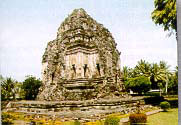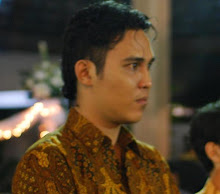
During Japanese colonization, many Indonesian people were sent to different regions to be employed as forced workers or romusha. They were forced to build various infrastructures to support the Japanese military to fight the Alliance. The people who served as romusha suffered so much; they did not get enough food and they were treated so severely that many of them died.
This made Sri Sultan Hamengku Buwono IX - the former king of Yogyakarta - felt a pity and tried to put the romusha away from Yogyakarta people. He ordered the people to build an irrigation ditch as long as 30 kilometers from the Progo River to the Opak River, and objected to let his people to join the romusha by claiming that they still had to finish the project. The ditch was named Yoshiro Canal and up to now, it functions to irrigate teen-thousands hectares of rice field.
Going along the bank of this historical irrigation ditch on a motorcycle or a mountain bike promises a pleasant experience when it is done in October - May since from June to September this ditch is dried to cut off the contamination cycle.
The perfect start would be from the crossroad near the building of Magister Management of Gadjah Mada University on Kaliurang Road. There are two choices of routes from this point. We may choose to go westwards to meet the upper stream of Progo River in Ancol village of Magelang Regency. Otherwise, we may go along the Mataram ditch to the east direction that will end in Opak River in Kalasan. Starting at 06:00 a.m. is the right time with fresh air and warm sun and we can see many activities of the agricultural community.
Westwards
If we take to go westwards, we will directly see the green rice field after passing by the west Ring Road. When the sun rises highly enough, we will see it shining brightly above the green rice field and coconut trees of which shadow will be seen on the surface of the ditch water that flows quietly. Sometimes, some nature-lovers from universities practice canoeing here.
After going as far as 16 kilometers, we will get to Barongan village. The road in the area is muddy and slippery like an off-road route. We have to be careful in order not to be slipped. On both sides, we will see irrigation shutters regulating the water distribution from the ditch to the rice field. You will soon learn the importance of this ditch for the agriculture in Sleman Regency.
On this "off-road", YogYES experienced some pleasant events such as seeing the people who were pasturing ducks, buffalos, or goats. Once, we felt excited as well as worried of being attacked by the buffalos when we passed in between them while they were grassing on both sides of the road. After a tiring journey through earth road as far as 1 kilometer, we will get to a blind road (see photo) that is obstructed by the Krasak River that forms as deep as 5 meters path. Usually, the ditch will keep flowing through a bridge on the river, but there is nothing here. Where does the water continue flowing then? It turns to flow downwards, through a pipe planted beneath the earth, then flow up to the other side of the river. What is amazing is that no water pump is used! The physics law stating that the surface of the water will always be even is applied here (see picture). If we ride a motorycle, we have to return to take an asphalted road. If we ride a mountain bike, we can carry it on our shoulder to cross the shallow river.
About 5 kilometers away from Krasak River, we will come to Ngluwar village. Again, we will get confused since the flow of the water in Mataram ditch seems to disappear at all. We cannot assume that we have arrived at the upper course of the ditch since it continues to flow through the tunnel beneath the village. It is so amazing, isn't it?
Two kilometers to the south of the village, we will get to the upper coarse of Mataram ditch, namely the Progo River. A small dam named Bendung Karang Talun dams up the flow of the Progo River. The water from the dam then flows to the Mataram ditch. On Ancol bridge, over the dam, we can admire the fast current of the Progo River that is also used for rafting. This is where our journey ends.
Eastwards
We will see different view if we choose to go along the ditch in the same direction as its current, eastwards. Some areas we are going to pass by are Gejayan, Depok, Maguwoharjo and Kalasan. From Gejayan to Depok, we will see the city nuance with the presence of buildings and food-stalls. If we had not had meals, we can drop by the Bu Wiryo SGPC (sego pecel or rice served with mixed vegetable topped with peanut sauce) restaurant to the north of the animal husbandry faculty of Gadjah Mada University.
We see the green rice field only when we arrive in Maguwoharjo area. In some areas, we have to take the earth road since the asphalted road is sometimes built not in the same direction with the ditch. Generally, the earth road in this east area is dry and thus is not slippery, but we have to be careful of not falling in the ditch. We will be ok if we should fall in the water but it will be too embarrassing!
After reaching the Kalasan area, we will see an impressive panorama. From the earth road on the right side of the ditch, we can see the middle to the upper parts of Tara Temple. The spread of rice field and high trees will be the foreground. If we want to visit the oldest Buddha temple in Yogyakarta, we can take the asphalted road to the right.
From this point, we still have to go eastwards to reach the lower course of the Mataram ditch. On the way, we will find the ditch flowing under the railway. About 1 kilometer ahead, we will get to the downstream of the Mataram ditch. The water of the ditch will flow downwards fast to meet the Opak River flowing southwards to the Indonesian Ocean. The surrounding scenery is quite beautiful. High trees grow at the bank of the Opak River. This scenery signals the end of our eastward journey alongside the Mataram ditch.
Exciting and Amazing
In addition to giving a pleasant experience, going along the Mataram ditch will make us admire the designer. The course of the water flowing from west to east seems to "oppose" the nature law since the Merapi Mountain in the north of Yogyakarta causes the river in this region to generally flow from north to south. The ditch crossing over teen of small rivers and going through the tunnel under the Krasak River by applying the physics law, has been supplying water for teen-thousands of rice field for tens of years and it has been one of the landmarks of Yogyakarta.




















